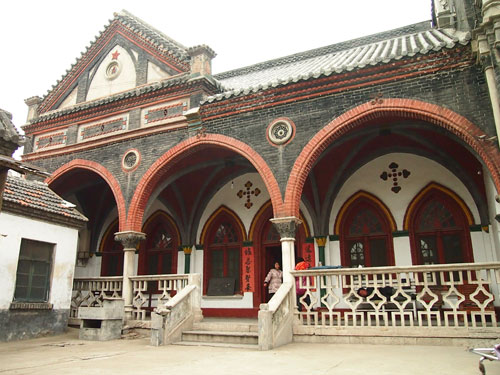
 'Taken 2' grabs movie box office crown
'Taken 2' grabs movie box office crown
 Rihanna's 'Diamonds' tops UK pop chart
Rihanna's 'Diamonds' tops UK pop chart
 Fans get look at vintage Rolling Stones
Fans get look at vintage Rolling Stones
 Celebrities attend Power of Women event
Celebrities attend Power of Women event
 Ang Lee breaks 'every rule' to make unlikely new Life of Pi film
Ang Lee breaks 'every rule' to make unlikely new Life of Pi film
 Rihanna almost thrown out of nightclub
Rihanna almost thrown out of nightclub
 'Dark Knight' wins weekend box office
'Dark Knight' wins weekend box office
 'Total Recall' stars gather in Beverly Hills
'Total Recall' stars gather in Beverly Hills
Legacy lingers for Yanzhou church
Updated: 2012-07-30 14:03
By Han Bingbin (China Daily)
|
||||||||
 |
|
The Yanzhou Catholic Church was built at the end of the 19th century. Han Bingbin/China Daily |
With a history of more than 4,000 years, Yanzhou in Shandong province often shares the honor of being the hometown of Confucianism because of its proximity to Qufu, the Sage's birthplace.
|
Related: |
It's also a place, as local government promotes it, where Buddhism and Christianity flourished together in history. While Buddhism is easy to trace - the more than 1,000-year-old Xinglong pagoda stands tall in the center of the city - the Christian footprint is harder to find.
But recently we were led through rows of gray bungalows and found a fragile church building that simply stood out in spite of its seeming plainness.
The roof arch and upturned eaves are decorated with bricks glazed in green, red and yellow. The ceiling of the corridor is a cupola with carved flowers opening up from the stone bases of corridor columns.
The Catholic church is now priest Wang Decheng's quiet home, where in addition to his religious duties, he spends considerable time serving as a knowledgeable tour guide. As he eagerly showed us a collection of old photos, the image of a magnificent Gothic building immediately brought us back to the church's past glory.
Once with 718 rooms that covered more than 83,646 square meters, it was one of the country's best-known and best-crafted Catholic churches.
Construction started in 1897. mooted by a German missionary. In 1899, the 21-meter tall Catholic cathedral opened its doors.
Over the next 50 years, it expanded into a multi-function religious compound. By 1946, a hospital, schools and handicraft workshops were completed.
But much of the architecture, along with historic relics such as books, religious vessels and utensils, were destroyed during the "cultural revolution" (1966-76).
One of those things lost in the turbulence of history, which Wang felt particularly sad about, is a giant pipe organ that took a German expert several painstaking months to assemble.

With more than 1,000 pipes - ranging from 5-meter tall to finger-size - that created 360 different tones, the pipe organ was one of East Asia's largest and one of only four of its kind in the world.
The organ had two power systems, one electrical and the other manual.
The former was used during big celebrations and important holidays. The latter, with only one row of keyboards, was used during regular church services, with a manual pedal board.
Even though I have never seen a pipe organ, the priest's enthusiastic description started a flight of fancy.
I started to imagine the picture of a devout artist standing before this giant instrument, trying to bring peace to the hearts of those praying inside this tranquil but inspiring space.
Most Viewed
Editor's Picks

|

|

|

|

|

|
Today's Top News
Health new priority for quake zone
Xi meets US top military officer
Japan's boats driven out of Diaoyu
China mulls online shopping legislation
Bird flu death toll rises to 22
Putin appoints new ambassador to China
Japanese ships blocked from Diaoyu Islands
Inspired by Guan, more Chinese pick up golf
US Weekly

|

|






